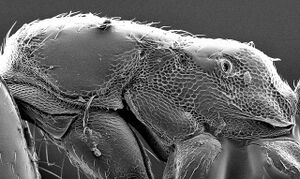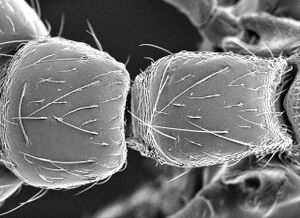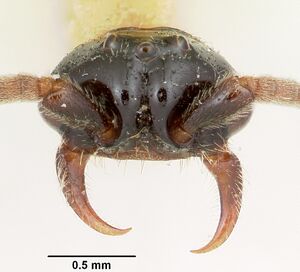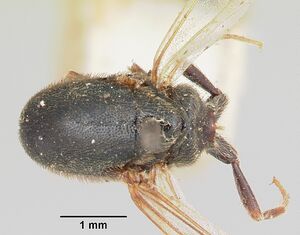Neivamyrmex microps
| Neivamyrmex microps | |
|---|---|

| |
| Scientific classification | |
| Kingdom: | Animalia |
| Phylum: | Arthropoda |
| Class: | Insecta |
| Order: | Hymenoptera |
| Family: | Formicidae |
| Subfamily: | Dorylinae |
| Genus: | Neivamyrmex |
| Species: | N. microps |
| Binomial name | |
| Neivamyrmex microps Borgmeier, 1955 | |
For many years known only from the type specimen, this species has recently been collected again in a number of Arizona localities. Although we now know that N. microps has a fairly extensive range within Arizona, it will likely continue to be a rarely collected species. Current records indicate that this species inhabits a wide range of habitats, having been found in areas ranging from Creosote scrub to Oak woodland, with an elevational range between 1000 and 4000 feet. Nothing is known of the biology of this species. However, label data indicate that the activity period for this species closely coincides with the summer/fall monsoon season in Arizona. (Snelling and Snelling 2007)
Identification
Snelling and Snelling (2007) - Worker. Eye absent; antennal scape not extending to midlength of head; head with numerous suberect hairs, but no erect hairs; propodeal dorsum smooth and shiny, distinctly longer than declivitous face, latter smooth and shiny; petiole node longer than broad in dorsal view, sides slightly convex; postpetiole slightly wider than long, disc smooth and shiny, sides weakly sculptured.
Workers may be confused with those of Neivamyrmex leonardi, but may be differentiated by the less well developed mandibular teeth, the longer, narrower postpetiole, and the less convex mesosomal profile.
Keys including this Species
Distribution
United States: Known only from Arizona, but almost certainly extends into adjacent eastern California and south into Mexico. (Snelling and Snelling 2007)
Latitudinal Distribution Pattern
Latitudinal Range: 34.05° to 31.51133333°.
| North Temperate |
North Subtropical |
Tropical | South Subtropical |
South Temperate |
- Source: AntMaps
Distribution based on Regional Taxon Lists
Nearctic Region: United States (type locality).
Distribution based on AntMaps
Distribution based on AntWeb specimens
Check data from AntWeb
Countries Occupied
| Number of countries occupied by this species based on AntWiki Regional Taxon Lists. In general, fewer countries occupied indicates a narrower range, while more countries indicates a more widespread species. |

|
Estimated Abundance
| Relative abundance based on number of AntMaps records per species (this species within the purple bar). Fewer records (to the left) indicates a less abundant/encountered species while more records (to the right) indicates more abundant/encountered species. |

|
Biology
Castes
Based on circumstantial evidence, we have associated the described workers with this species. They were collected in Maricopa County, along 4 Peaks Road by R. A. Johnson, 27 March 1993. These workers belong to the correct species group and the known distribution makes this association probable. (Snelling and Snelling 2007)
Worker
    
| |
| . | |
Male
 
| |
| . | |
Images from AntWeb
       
| |
| Type of Neivamyrmex microps. Male (alate). Specimen code casent0105788. Photographer April Nobile, uploaded by California Academy of Sciences. | Owned by USNM, Washington, DC, USA. |
Nomenclature
The following information is derived from Barry Bolton's Online Catalogue of the Ants of the World.
- microps. Neivamyrmex microps Borgmeier, 1955: 635, pl. 56, figs. 6, 10; pl. 80, fig. 4 (m.) U.S.A. (Arizona).
- Type-material: holotype male.
- Type-locality: U.S.A.: Arizona, Phoenix, 15.x.1933 (R.H. Randall).
- Type-depository: USNM.
- Snelling, G.C. & Snelling, 2007: 480 (w.).
- Status as species: Smith, M.R. 1958c: 109; Watkins, 1972: 352 (in key); Hunt & Snelling, 1975: 21; Watkins, 1976: 25 (in key); Smith, D.R. 1979: 1331; Watkins, 1985: 485 (in key); Bolton, 1995b: 290; Snelling, G.C. & Snelling, 2007: 480.
- Distribution: U.S.A.
Unless otherwise noted the text for the remainder of this section is reported from the publication that includes the original description.
Description
Worker
Snelling and Snelling (2007) - measurements (mm) (n = 12): HW 0.59; HL 0.73; SL 0.34; SW 0.11; PW 0.22; ML 0.36; PL 0.27; PpW 0.29; PpL 0.22; HFL 0.50; HFW 0.15. Indices: CI 70-85 FI 28-39; SI 39-51 Head distinctly longer than broad; smooth and shiny with only scattered small punctures. Eye absent. Dorsolateral corners slightly angulate, preoccipital carina weak. Scape not reaching middle of head length, 3 x as long as greatest breadth, broad distad, abruptly narrowed at base. Subantennal lamella well developed. Head without erect hairs, but with numerous suberect hairs. Mandible triangular, upper margin straight and distinctly angulate at juncture with masticatory margin; upper margin with distinct small distal tooth.
Mesosomal dorsum smooth and shiny; promesonotal suture indistinct; metanotal groove distinct. Propodeal dorsum smooth and shiny, distinctly longer than declivitous face, latter smooth and shiny. Metafemur stout. Petiole node longer than broad in dorsal view with sides slightly convex and narrowing anteriorly; evenly convex in lateral view; sides slightly granulate; subpetiolar tooth minute. Postpetiole slightly wider than long, dorsum smooth and shiny, sides lightly granulopunctate.
Gaster smooth and shiny on first tergum, second segment weakly sculptured and less shiny.
Type Material
In the original description of this species Borgmeier incorrectly cited the collector of the type specimen as “R. H. Randall”; the correct name is R. H. Crandall.
References
- Borgmeier, T. 1955. Die Wanderameisen der neotropischen Region. Stud. Entomol. 3: 1-720 (page 635, pl.56, figs. 6, 10; pl. 80, fig. 4 male described)
- Snelling, G. C. and R. R. Snelling. 2007. New synonymy, new species, new keys to Neivamyrmex army ants of the United States. Pages 459-550 in Snelling, R. R., B. L. Fisher and P. S. Ward. Advances in ant systematics (Hymenoptera: Formicidae): Homage to E.O. Wilson - 50 years of contributions. Memoirs of the American Entomological Institute, 80.
References based on Global Ant Biodiversity Informatics
- Johnson R. Personnal Database. Accessed on February 5th 2014 at http://www.asu.edu/clas/sirgtools/resources.htm
- Snelling G. C. and R. R. Snelling. 2007. New synonymy, new species, new keys to Neivamyrmex army ants of the United States. Memoirs of the American Entomological Institute 80: 459-550

